| Release List | Reviews | Price Search | Shop | Newsletter | Forum | DVD Giveaways | Blu-Ray/ HD DVD | Advertise |
| Reviews & Columns |
|
Reviews DVD TV on DVD HD DVD/Blu-ray International DVDs Theatrical Reviews by Studio Video Games Features Collector Series DVDs Easter Egg Database Interviews DVD Talk TV DVD Talk Radio Feature Articles Columns Anime Talk DVD Savant HD Talk Horror DVDs Silent DVD
|
DVD Talk Forum |
|
|
| Resources |
|
DVD Price Search Customer Service #'s RCE Info Links |
|
Columns
|
 |
The Warner |
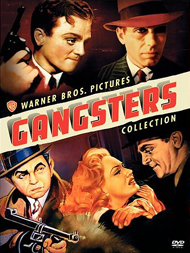
|
The Warner Gangsters Collection Warner DVD 1930-1949 B&W 1:37 flat full frame Street Date January 25, 2005 68.92 Little Caesar, The Public Enemy, The Petrified Forest, Angels with Dirty Faces, The Roaring Twenties & White Heat |
Warners has dug deep down into its inventory and pulled out six titles that are the core of their golden-era image, the elite of the Gangster film. Paramount and Josef von Sternberg kicked off the genre in the silent era, but once one gets past the independently produced classic Scarface there are only a handful of hardcore gangster films from other studios worth mentioning.
The selection includes essential debut titles by Edward G. Robinson and James Cagney and shows both the artsy and commercial extremes of the developing genre in a trio of melodramas with Humphrey Bogart as a supporting character. The capper is a mind-blowing noir-gangster epic that puts paid to the classic era while pointing toward a new post-war world of violent chaos.
As a body of work these machine-gun epics really deliver the goods. Viewers familiar only with newer retro looks at gangland, USA will be able to make a lot of thematic connections while enjoying the snappy performances and limit-pushing action. The violence and sexual situations in these thrillers are still impressive and audacious.
The studio's painstaking efforts to give these pictures a facelift for DVD really pays off; besides the general excellence, some beautiful new sources were found for the two oldest titles.
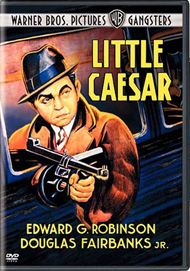
|
Little Caesar 1930 / 78 min. / Available Separately at 19.97 Starring Edward G. Robinson, Douglas Fairbanks Jr., Glenda Farrell, Sidney Blackmer, Thomas E. Jackson, Stanley Fields Cinematography Tony Gaudio Art Direction Anton Grot Film Editor Ray Curtiss Written by Francis Edward Faragoh, Robert N. Lee, Robert Lord from the novel by W.R. Burnett Produced by Hal B. Wallis Directed by Mervyn LeRoy |
Little Caesar sets the basic template for every urban gangland bio to come. Punk hoodlum Rico has ambition and drive but little judgment, and is tempted by power even though he fastidiously refuses to drink. Whether it be taking over his little gang or hurrying to rub out a squealer, all of his moves are urgent, and this accelerates the story tempo far faster than the typical talkie of the day ... remember, in 1930 the studios were barely beyond the "talk into the bush" stage.
Rico's delusions of grandeur take him high into the rackets but he succumbs to the classic gangster flaw - a streak of human feeling that betrays his credo of absolute ruthlessness. When survival depends on killing his old pal Joe Massara, he can't do it. Little Caesar shows its pre-code willingness to be adult by hinting that Rico may have an unacknowledged homosexual attraction to Joe, the stick-up criminal who (rather unlikely) is also a cultured, refined exhibition dancer. When Rico objects to Joe's romance with a female dance partner, we don't know if Joe is incensed for business reasons or jealousy.
Savant hasn't seen all of the gangster films of this period but most of the silent antecedents pictured their criminal protagonists as outlaw heroes that partially redeem themselves through a noble sacrifice - going to prison, confessing, etc. - so that some more deserving buddy can get the girl. Rico Bandello is as nasty on the way down as he was at the top, so much so that the crafty policeman Flaherty can easily goad him into showing himself. Rico's dishonorable demise is the classic gangster's death in a gutter, overseen by a poster of the lovers who are now free (at least we hope so, as they didn't make any immunity deal). He wails "Mother of Mercy" and goes out like the rat he is. Note: I've read that the line is actually a censored redub of "Mother of God", but in the film we can see, Rico's lips seem to say "Mercy."
Little Caesar is static in the direction department but Mervyn Leroy uses the camera effectively to tell his story and point out important details like the fancy jewelry that so impresses Rico. Edward G. Robinson has to carry the entire show as none of the other actors seem particularly comfortable in their roles, especially the miscast Douglas Fairbanks, Jr.. Glenda Farrell hasn't hit her wisecracking pace yet and doesn't draw much attention. Still playing to the Vitaphone microphones, actors like Thomas E. Jackson and Stanley Fields seem mostly interested in talking slowly and enunciating their lines clearly.
The print on view of Little Caesar looks great. More than half of it appears to be sourced from something far better than what was available for an early-90's laserdisc, a blah copy that was contrasty and dull. They must have been mixing and matching between sources, because some scenes in this oft-printed and under-protected movie look as clear as a bell.
Each of the titles in this collection has an elaborate list of extras fronted by a Leonard Maltin host introduction that precedes a "night at the movies" slate of short subjects. In this disc we get a trailer, the brain-altering Merrie Melodie cartoon Lady Play Your Mandolin and a lame but amusing dramatic short with Spencer Tracy, The Hard Guy. On the academic side of things is a commentary by Richard B. Jewell and a featurette that gathers a number of authors of genre criticism. There's also the censor-mandated text crawl that preceded the 1954 reissue.
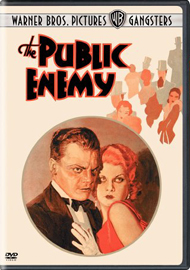
|
The Public Enemy 1931 / 83 min. / Available Separately at 19.97 Starring James Cagney, Edward Woods, Jean Harlow, Joan Blondell, Beryl Mercer, Donald Cook, Mae Clarke Cinematography Dev Jennings Art Direction Max Parker Film Editor Edw. M. McDermott Written by Harvey Thew from the story Beer and Blood by Kubec Glasmon & John Bright Produced by Darryl F. Zanuck Directed by William A. Wellman |
Made not long after Little Caesar, The Public Enemy is far more advanced in direction, storytelling technique and acting. The Warner house style is more evident here and much more of the story plays out in broad daylight.
The script puts a strong emphasis on environmental factors as the source of crime, a theme that became a cornerstone of Warners' socially conscious 30s outlook. Tom Powers and Matt Doyle spend over a reel as slum kids who fall into the employ of a local fence called Putty Nose, (Murray Kinnell). Tom's stern father, a policeman, beats him regularly but all we see on the boy's face is resentment and the desire to strike back.
By the time Tom Powers turns into the immensely magnetic actor James Cagney, he's a budding sociopath and doesn't give a damn what happens to the victims of his crimes. When prohibition hits he peddles one gang's brand of beer and uses thug tactics to intimidate anyone who won't buy it. The classic scene where Cagney roughs up a speakeasy owner, spits in his face and lets the competitor's beer run on the floor is the perfect distillation of cutthroat business practices in action. Thirty-six years later, Roger Corman copied the scene exactly with George Segal in The St. Valentine's Day Massacre and couldn't improve on it.
Although given excellent support on both sides of the camera, James Cagney is sensational all on his own. Every scene shows him arrogantly demonstrating his street-smart style, always making sly faces at people, doing little punching motions (even to his own clueless mother) and the occasional dance-like piroutte entering cars or jumping out of trucks. We can't take our eyes off of him - he's just so much more 'real' than anyone else. The bluenoses must have turned purple to see how Cagney made bad behavior - acting snide, pushy and aggressive - so attractive. We're invited to cheer him on when he mocks a gay tailor. Every rule of civilized behavior goes out the window when he socks Mae Clarke in the face with a grapefruit.
Tom Powers is a tough guy but he doesn't know his own limitations. He can't deny that his family means something to him, although they're never directly threatened because of his criminality. He's constantly being fooled by his bosses but never thinks to "take over" as would Enrico Bandello. The classier grade of moll represented by Jean Harlow makes him feel sexually insecure. An accident with a horse leads to a bizarre rub-out, a revenge echoed much later with a horse's head in The Godfather. Finally, Tom takes the murder of his best buddy - an efficient slaying carried out with Army-issue machine guns - as a cue to single-handedly charge into a den of enemies. It doesn't work out quite as he hopes, and Tom Powers becomes another candidate for the gutter.
The script avoids directly showing gunplay, and The Public Enemy's chilling ending is bolstered by director William Wellman's macabre but restrained staging. Reform school counselors have always run into a brick wall when trying to get delinquents to consider the effect of their crimes on their poor mothers, and this conclusion is like something out of Edgar Allan Poe. Wellman cannily sets us up by showing Tom's mother happily changing bedsheets in preparation for her boy coming home, the boy who has already admitted to himself that he "ain't so tough" and is perhaps genuinely ready to reform. It's a great and uncompromised ending to a thoroughly remarkable show, one of the best movies of the thirties.
Jean Harlow's performace is almost entirely her zowie looks, as she barely gets through her coached dialogue. Edward Woods is good as Tom's buddy and Joan Blondell makes a winning impression as a gangster's wife. Mae Clark's bimbo moll has been the butt of grapefruit jokes ever since. I believe that Cagney socked her for real - she seems truly surprised - but I'm not sure I believe that a real marksman with a loaded Thompson submachine gun did any shooting with Cagney or Woods for the rub-out scene, as claimed in some books. The famous photo of that setup is probably just that - a setup.
The picture quality of The Public Enemy is a true revelation. Although the packaging text doesn't herald the fact the news leaked out a while back that Warners had lucked on to a surviving good element for the film. Along with Little Caesar this film had been reissued and printed so many times that the standard elements must have been bad dupes of bad dupes. Television copies and even archival prints were simply terrible - blurry and misframed dupes with scratchy audio. There are a few scenes here that revert to poorer quality but at least 95% of this presentation looks like it was filmed yesterday. The images have a pep to them I've never seen before, and even the early 30s makeup jobs look more natural - Cagney appears to wear lipstick and eyeshadow. This quantum jump in quality makes us pine for a release of the Barbara Stanwyck film Baby Face, an salacious pre-code bad-girl saga for which Warners has rediscovered an uncensored pre-release version!
Leonard Maltin is back to introduce more vault goodies. The Eyes Have It is an early Edgar Bergen-Charlie comedy short and Smile, Darn Ya another surreal cartoon set to a quirky pop tune of the day. The commentary this time around is by Robert Sklar, who also appears in the featurette Beer and Blood: Enemies of the Public with a particularly entertaining Martin Scorsese and Alain Silver, Savant's inspiration in film noir writing. They don't have a trailer for this one but we see a vintage newsreel and a trailer for another Cagney film. The 1954 censor text scroll is included as well.
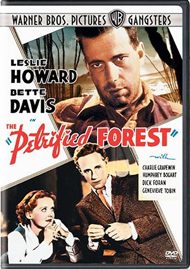
|
The Petrified Forest 1936 / 83 min. / Available Separately at 19.97 Starring Leslie Howard, Bette Davis, Humphrey Bogart, Genevieve Tobin, Dick Foran, Joe Sawyer, Porter Hall, Charley Grapewin Cinematography Sol Polito Art Direction John Hughes Film Editor Owen Marks Written by Charles Kenyon, Delmer Daves from the play by Robert E. Sherwood Directed by Archie L. Mayo |
Superficial gangster fans may steer clear of The Petrified Forest, a talkfest that spends more time on philosophical poetics than gritty action. But it introduced Humphrey Bogart as potential star material and is a masterful example of a play adapted to the screen. It's at least as effective as Key Largo, which in retrospective plays like a reworked version.
Self-styled intellectual Alan Squier (who claims not to be English) runs up against killer diller John Dillinger substitute Humphrey Bogart, who we're told affects the same dress and some of the mannerisms of the famous bank robber. A nicely-orchestrated cross section of supporting players allows playright Sherwood to score some unflattering points about American attitudes. The wife of a banker turns virtuous under the seige; the pushy football player makes a dumb try at heroism, and the old codger (Charley Grapewin at his best) loves Duke Mantee because he has fond memories of Billy the Kid! Bette Davis' father Porter Hall belongs to a sinister-sounding paramilitary group called The Black Horse Troopers. Sherwood even reserves a good dialogue exchange for two black characters, outlaw and chauffeur, a rare thing in movies of the day.
Leslie Howard is too earnest to seem effete as he rattles on about fate and courage in poetic terms. It's easy to see why both Bette Davis' Gabby and the female public at large adored this fantastic character not likely to be found in real life. Under the truth serum alcohol, both Squier and Mantee bring their feelings out in the open, and Mantee is revealed to be a kindred lost soul working his way toward the same grave Squier sees in his own future. Squier has a death wish and makes a deal for Mantee to shoot him dead on his way out the door ... giving the players two or three varieties of nobility and poetic irony to chew on. It's the kind of slightly delirious play that has average people make stylized speeches about abstract concepts. Howard's character blabs a lot, and Bogart communicates his feelings in a few terse statements.
Many viewers don't think that rural outlaw bandits are real gangsters, but anybody with a gang qualifies, even The Wild Bunch, a western that borrows some potent gangster images for its flashback scenes. As the scholars on this disc's featurette claim, Dillinger, Pretty Boy Floyd and Bonnie & Clyde can be distinguished as 2nd or third generation Americans. The old codger makes a cogent remark about Mantee being "American" instead of "foreign," by which he means that Mantee's a homegrown menace instead of one of those despised immigrants. The immigrant urban gangsters come from ghettos and are ambitious practitioners of the American way of business, skipping all the rules. Rural bandits like Mantee are the disillusioned product of economic failure, born of the dustbowl and righting perceived wrongs by striking back against society.
People who make fun of Bette Davis usually haven't seen her movies. Her acting is always interesting and excellent in thoughtful work like this, playing opposite a worthwhile leading man. In his own way Bogart is another step toward modern screen acting. His imposing presence and craggy face do most of the work; instead of actively emoting he inhabits the character and lets his eyes carry his intent. The opening shots of him walking with his arms in an apelike posture are a bit thick, but beyond that, no complaints.
For 1936, this is an extremely fluid and imaginative staging of what is basically a one-room play. Archie Mayo's name doesn't come up in any lists of great directors but he hit the nail on the head this time.
Warners' DVD of The Petrified Forest is again a nicely cleaned-up restoration. The studio look of the time didn't go in for deep blacks and the image reflects this while giving the stagey sets a dusty look. The sound has been particularly improved from old 16mm TV prints - the movie no longer plays like a fossil.
By now we're used to the convocation of experts that gather to explain the film in the featurette, Menace in the Desert. The commentary is by Eric Lax. An elaborate extra is an entire 1940 radio adaptation with Bogart, Tyrone Power and Joan Bennett.
Leonard Maltin's string of short subjects includes a newsreel, a grating musical short Rhythmitis, the cartoon Coo Coo Nut Grove and a trailer for Bullets or Ballots.
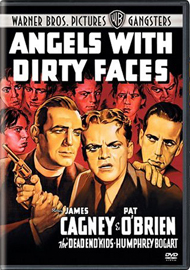
|
Angels with Dirty Faces 1938 / 97 min. / Available Separately at 19.97 Starring James Cagney, Pat O'Brien, Humphrey Bogart, Ann Sheridan, George Bancroft, Billy Halop, Bobby Jordan, Leo Gorcey, Gabriel Dell, Huntz Hall, Bernard Punsly Cinematography Sol Polito Art Direction Robert Haas Film Editor Owen Marks Original Music Max Steiner Written by John Wexley, Warren Duff story by Rowland Brown Directed by Michael Curtiz |
Angels with Dirty Faces is probably the popular favorite of the films in this collection, but it's a case of charisma over content. Most of the other titles are groundbreaking films with dangerous ideas but Angels is a sanitized rehash of gangster themes tailored to appeal to all audiences. It comes complete with sermons and a foundation of strict moral values underpin every plot point. It's custom-fit to provide powerhouse actor James Cagney a vehicle he could sink his teeth into, while appealing to the growing number of state, local and religious censor boards as morally uplifting entertainment.
When the production code outlawed gangster heroes in 1934 Warners turned to G-Men and police heroes, but the public wanted their bad boys back. Angels with Dirty Faces jams in sentimental elements one would expect to see in Boy's Town along with noble priests with pious motives. But even staying within the narrow scope of behavior allowed him, Cagney's gangster wins over O'Brien's priest. Even the mock-tough Dead End Kids get away with twenty minutes of cheating, dirty tricks and casual rough stuff; as kids we cheered their every sucker punch and sneering remark.
By this time Michael Curtiz' direction was reaching its peak of fluidity and invention. His introductory shots of Rocky's habitat make good use of a swooping crane and there are more effective closeups of Cagney here than perhaps in any other movie. I'll bet Joan Crawford wished she could get this kind of vehicle, with a script and photography dedicated to making the star look good!
Angels stretches the classic theme of friends on opposite sides of the law, with Rocky and Jerry Connolly palsy-walsy despite the fact that they should be at each others' throats. The priest (whose church was responsible for the Hollywood inquisition that made this movie possible) is tolerant and faultless even to point of sticking with Rocky through several more murders, perhaps even of policemen. The whirlwind of public support for Father Connelly's reform movement is a lift right out of the Frank Capra playbook.
The plot drops some threads along the way. Attractive Ann Sheridan is set up to be seduced by Rocky's gambling club after she's offered a high-paying job as a hostess, but from that point on her role suddenly evaporates. The film also manipulates the audience with a stack of plot crescendoes on the theme of nobility. Rocky talks tough but throws away his lifestyle and his liberty by rubbing out his rat partners when they threaten Father Jerry. Father Jerry starts a vigilante movement against his own 'blood brother' because of allegiance to a higher cause.
And then there's the famous miracle ending, as contrived as anything witnessed or invented for the lives of the Saints. It's the knockout scene that sealed the film's reputation and it has a lot more to do with brilliant narrative strategy than it does the gangster genre - the film could be called The Miracle of Our Lady of the Electric Chair, or The Song of Rocky Sullivan, Coward. It's great filmmaking but thematically it puts the gangster film back into kindergarten.
I don't know how much of the street patter of "The Dead End Kids" - Billy Halop, Leo Gorcey, Huntz Hall & co. - was authentic and how much was stage invention. Punk attitudes haven't changed, as the boys are chronic cheaters in a gang that rewards punk behavior. When one is caught red-handed his invariable reaction is whining innocence: "What did I do?" Kids in the audience expecting to see punishment for every rule broken felt cheated when the Dead End gang avoided the consequences of its actions. This was perhaps the beginning of the indulgent mindset that philosophized about the roots of delinquency and concluded that all the little &%#$@'s needed was a little kindness and understanding.
The heritage of the Dead End Kids (beyond a long string of cheap, entertaining films, and the behavior of elected officials) is their immortalization in the Jets of West Side Story. Arthur Laurents clearly didn't know much about 1956 street thugs and fell back on an exact copy of Dead End-style clowning for his characterizations.
Angels with Dirty Faces would be an effective fairy tale if it didn't have to pander to the strict production code of its day. Cagney is at his zenith as a movie star here, a real dynamo, but Savant prefers him in pictures with more merit.
Warners' DVD of Angels with Dirty Faces hasn't been given the back-to-the-roots facelift of the other films in this set. The picture is sharp and the encoding good, but the element has many fine scratches and even a bad negative splice and jump in the scene where Sheridan and Cagney walk home. The sound is as punchy as the other titles (including the main theme that's identical to the score of the later White Heat) but perhaps they went to the vault on this one and found the cupboard was bare. Don't get me wrong - it still plays marvellously and looks better than most vintage titles from other studios. Warners is spoiling us with quality this year.
The docu this time around has plenty of meat for the assembled experts to mull over, although almost all of them respond to this title as a sentimental favorite and stay away from making a case for greater significance. Leonard Maltin proffers a fine crop of 1938 short subjects starting with newsreels about the clouds of war hovering over Europe. A Porky Pig & Daffy Duck cartoon is hilarious and an elaborate Technicolor musical short is about a hopeful who tags along with a studio tour and immediately finds herself filming a dance number. There are also the requisite trailers and an impressive radio version of Angels starring Bogie and his pal Pat O'Brien.
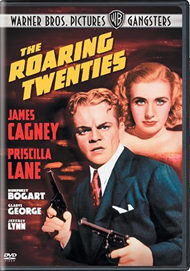
|
The Roaring Twenties 1939 / 104 min. / Available Separately at 19.97 Starring James Cagney, Priscilla Lane, Humphrey Bogart, Gladys George, Jeffrey Lynn, Frank McHugh Cinematography Ernie Haller Production Designer Art Direction Max Parker Film Editor Jack Killifer Written by Robert Rossen, Jerry Wald, Richard Macaulay from the story The World Moves On by Mark Hellinger Produced by Samuel Bischoff, Hal B. Wallis, Jack L. Warner Directed by Raoul Walsh |
By 1939 Warner gangsters have become nostalgic, and The Roaring Twenties plays like Gangland's Greatest Hits. If you're confused about the historic timetable of the events in gangster films, this one will straighten it all out. Mark Hellinger's source story inspires the organization of the show along newsreel lines, prefiguring the noir semi-docu craze and even to some extent Citizen Kane. We get details of the Volstead act and there are references to 3.2 Beer after the repeal; terrific montages from the Warner effects department (courtesy of soon-to-direct Byron Haskin) match new Dutch-angled scenes with stock footage from practically every crime movie done at the studio. One shot of a speeding car tossing bombs at a storefront is a second angle on a setup from Little Caesar - look closely and you'll see the 'bombs' bounce harmlessly back into the street as the conspicuously glass-less shop spontaneously explodes.
Cagney could act this one in his sleep but he's still a magnetic personality. Eddie Bartlett is an okay guy who becomes a criminal because of hard economic times. There are plenty of ratlike hoods to serve as real villains. Still being abused by the studio casting office, Humphrey Bogart is again an unredeemable creep. His slimy henchman Lefty is Abner Biberman, who would soon be playing evil asians in war movies. Only ethnic sensitivity (?) could result in the obviously Italian gang leader being played by Paul Kelly without a hint of Italian flavor. Like most Warners gangster sagas post- Little Caesar, this is an all-Irish mob, see?
Bartlett was ostensibly based on a real crook named Larry Fay and Panama is clearly meant to be Texas Guinan (later played by Phyllis Diller in Splendor in the Grass). Bartlett's management of a girl singer / sweetheart smacks more than a little of the Ruth Etting / Marty the Gimp relationship in the musical drama Love Me Or Leave Me. Cagney's unlikeable hood in that film is the link to the despicable characters found in more modern Martin Scorsese films.
The Roaring Twenties has a crackling pace and bristles with fresh action scenes. We see a booze hijacking on the high seas, a warehouse robbery and a showdown in an Italian restaurant that seems to be a fixture of the genre from Scarface to The Godfather. If the movie has a weak link, it's Priscilla Lane's showgirl. She's convincing as a high schooler but just sounds terrible up on stage, even when the movie tells us she's becoming a better singer. The standards she sings have little feeling. Remember Robert Mitchum's attitude statement in Out of the Past? Talking about a broken down nightclub, he says "I was in there so long I thought somebody was gonna break out with Melancholy Baby." Here they do it several times.
Once again, Cagney's given an A+ sentimental exit, making the supreme sacrifice to help out an ex-girlfriend who never returned his feelings. Cagney must have had a hand in blocking out the gundowns and other mayhem; it all looks great. The final shot is like an urban Pietá with the ex- Big Shot cradled in the arms of his moll on the snowy steps of some civic building.
Bogart gets his just desserts but came out smiling in the end: director Raoul Walsh believed in him enough to let him do High Sierra the next year, and between that and The Maltese Falcon, Bogie became a star.
Warners' DVD of The Roaring Twenties is another fine restoration with particularly punchy sound. The only flaw I found were two short passages where the audio lost synchronization, and they were brief.
The docu this time is brief as well, as the assembled critics note salient facts about the film and its nostalgia factor but don't dig as deeply as they do on the other pictures. The commentarian is film historian Dr. Lincoln Hurst. Leonard Maltin gives us a fun bunch of extras, including two comedy short subjects. One is a silly musical with a very young, pre-MGM June Allyson as a female mayor for a day. The trailer is for Each Dawn I Die. The cartoon - in Technicolor, finally - is the hilarious Thugs with Dirty Mugs, a warped look at gangsters with an Edward G. Robinson parody. The gags play like the work of Tex Avery but I could be mistaken as the main titles are a later replacement that omit all credits.
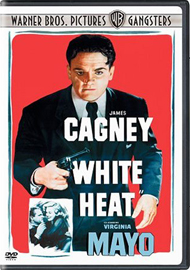
|
White Heat 1949 / 114 min. / Available Separately at 19.97 Starring James Cagney, Virginia Mayo, Edmond O'Brien, Margaret Wycherly, Steve Cochran, John Archer, Wally Cassell, Fred Clark Cinematography Sid Hickox Art Direction Edward Carrere Original Music Max Steiner Written by Ivan Goff, Ben Roberts story by Virginia Kellogg Produced by Louis F. Edelman Directed by Raoul Walsh |
White Heat must have been one impressive action film in 1949. Audiences rally behind its out-of-control violence now. It's thrilling to watch Cody Jarrett in action in a story so tightly constructed that it became a model for the studio's heightened cutting style. This isn't the kind of movie that holds shots for emotional effect. Day turns to night during a chase scene in four fast cuts, and the explosive ending rushes past a "the end" card so quickly we don't know what's hit us.
After avoiding gangster roles for a decade James Cagney relaunched his studio career with a socko updating of the genre. Unlike other films noir this isn't moody, romantic or melancholy; it instead advocates the idea that crime and societal chaos are rushing toward some kind of apocalypse. Clues that the country is just out of a war are everywhere, and now all of the modern tools of warfare are being applied to the pursuit of vicious criminals like Cody Jarrett: improved communications, coordinated planning, even radio positioning science. As if acknowledging that the country needs to turn its war machinery loose on domestic problems, an entire army converges on Cody at the end. He's not caught in the familiar 'old warehouse' but in a ridiculously complex oil refinery that looks like a technological maze, a post-modern labyrinth - the inside of a computer, perhaps.
Cody uses the wiles of a fox to elude the law, even going so far as to serve one prison term to avoid exposure for a more serious crime. He never understands that new technology is tripping him up although the classic gangster pitfall, personal betrayal is what seals his doom. Although a vicious renegade Cody has strong personal ties ("What's mine is mine") and a pathological relationship with his mother, a Ma Barker-type psychopath in her own right. Call it Oedipal or whatever, the relationship is outrageous, with Cody sitting on his mother's lap. He suffers from scorching migranes that only she can calm down, violent seizures that relate to the "white heat" of the title.
The Roaring Twenties was a rerun of familiar territory but White Heat makes all the genre trimmings look new. There's a new ruthlessness and sadism to the violence - people are casually executed with pistols and threatened with gruesome industrial accidents. Luckless henchman "Zucky" is scalded practically to death by steam (more white heat), and elsewhere there are brutal beatings, quick-draw reversals and a cold-blooded murder in the trunk of an automobile that still chills ("Okay Parker, I'll give ya a little air!"). The movie's extended prison section outdoes all the earlier Big House epics and the finish is an elaborate caper that looks forward to the multi-climaxed action cinema of today.
White Heat is incredibly influential to the thriller culture, even in unexpected directions. Cody Jarrett takes on a Fantomas-like aura as his own confederates fear him and behave as if he has supernatural powers. When Vic Pardo has him dead to rights with a shotgun, Jarrett's maniacal laugh makes Pardo unsure if he indeed has the upper hand. Ian Fleming must have been a huge fan of the movie, for he appropriated key material for his 007 superspy including the idea of a man waiting beside a decoy bed to ambush an assassin (Big Ed and Cody / James Bond and Doctor Dent in Dr. No). White Heat is practically remade in Fleming's book Goldfinger - undercover operative Vic Pardo goes along with Cody on his big crime - that's even verbally compared to a raid on Fort Knox! - and on the day of the big caper is thwarted in his efforts to alert the authorities. Both Pardo and Bond leave desperate notes behind them, hoping that they'll get to the right people. In both cases the big caper is interrupted by a military assault. Of course, in White Heat Pardo actually has a reason central to the story to be part of Cody's gang for the big heist ... in James Bond the screenwriters must always invent some unlikely reason why the arch-criminal doesn't just kill him.
White Heat is forward-looking in other ways too. The war is over and crime is no longer an immigrant's game. The law has wised up and there are millions of trained and qualified ex-soldiers swelling the ranks of law enforcement. Getting rich quick has been replaced by an existential quest to beat a system too complicated to figure all the angles. And there are new anxieties, neuroses and instabilities. The world is heading toward a nervous breakdown right along with Cody Jarrett. He's crazy all right, but there's something grandiosely timely to his self-willed immolation atop a million gallons of gasoline. The film ends in a series of conflagrations that poetically bring the gangster film up to date with the atomic age.
Along the way we have plenty of terrific performances to enjoy. Steve Cochran is swarthy and uncouth, Virginia Mayo is delightfully cheap (snoring, spitting out chewing gum) and Margaret Wycherly's daffy old nut is so convincing she's not even funny. It's also fun seeing Mickey Knox, the translator and English version producer of a pair of Leone films, in an early role as one of Cody's gang.
Warners' DVD of White Heat is given a high polish on this very desirable disc. The laser release wasn't very good looking, and the heightened clarity and definition of DVD yields a lot more detail. On a large monitor we can see Cody atop those dome tanks, which look huge.
The novelty extras are a Joe Doakes comedy short called So You Think You're Not Guilty, the cartoon Homeless Hare, a newsreel and some trailers. The featurette docu is one of the better in the set, with a contribution from critic Andrew Sarris among the gathered experts. The commentary this time around is by Dr. Drew Casper.
A special thanks needs to be given for the use of original ad art for these DVD releases. Warners is one studio that's not afraid to admit that their vintage classics are over twenty years old and aren't in color. The sneaky WB art department got away with murder in the poster for The Roaring Twenties by recycling an image of Cagney from the previous year's Angels with Dirty Faces. Take a look.
It was said that crime doesn't pay, except for the Warner Brothers. This set of great gangster films is only the beginning of what's coming this year from the Shield: Errol Flynn movies, Crawford-Davis moies, more film noir. With MGM, RKO and even some Allied Artists titles to draw from, Warners can keep releasing creative packages like this for years and never run dry.
On a scale of Excellent, Good, Fair, and Poor,
The Warner Gangsters Collection rates:
Movie: Excellent
Video: Excellent
Sound: Excellent
Supplements: see individual remarks above
Packaging: Keep case
Reviewed: February 5, 2005
Review Staff | About DVD Talk | Newsletter Subscribe | Join DVD Talk Forum
Copyright © DVDTalk.com All rights reserved | Privacy Policy
|
| Release List | Reviews | Price Search | Shop | SUBSCRIBE | Forum | DVD Giveaways | Blu-Ray/ HD DVD | Advertise |





